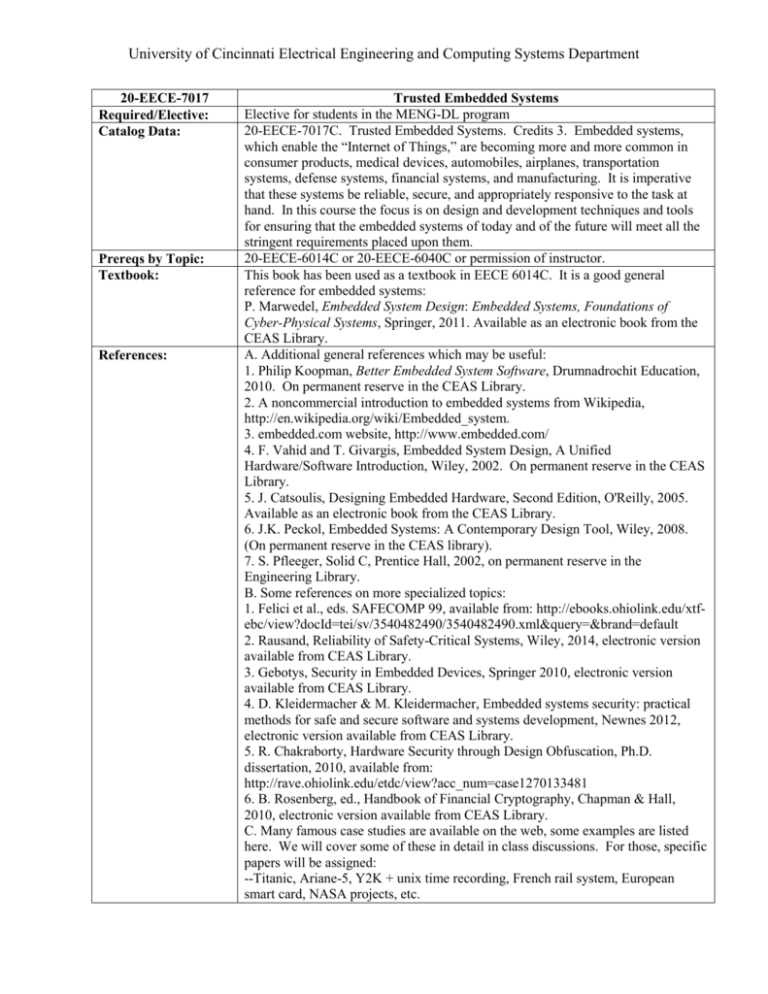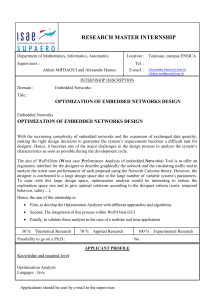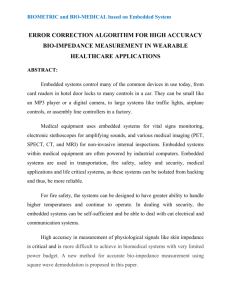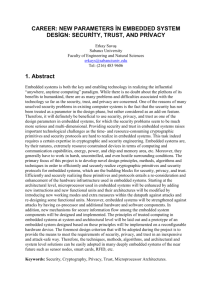20-EECE-7017--Trusted Embedded Systems (MENG-DL)
advertisement

University of Cincinnati Electrical Engineering and Computing Systems Department 20-EECE-7017 Required/Elective: Catalog Data: Prereqs by Topic: Textbook: References: Trusted Embedded Systems Elective for students in the MENG-DL program 20-EECE-7017C. Trusted Embedded Systems. Credits 3. Embedded systems, which enable the “Internet of Things,” are becoming more and more common in consumer products, medical devices, automobiles, airplanes, transportation systems, defense systems, financial systems, and manufacturing. It is imperative that these systems be reliable, secure, and appropriately responsive to the task at hand. In this course the focus is on design and development techniques and tools for ensuring that the embedded systems of today and of the future will meet all the stringent requirements placed upon them. 20-EECE-6014C or 20-EECE-6040C or permission of instructor. This book has been used as a textbook in EECE 6014C. It is a good general reference for embedded systems: P. Marwedel, Embedded System Design: Embedded Systems, Foundations of Cyber-Physical Systems, Springer, 2011. Available as an electronic book from the CEAS Library. A. Additional general references which may be useful: 1. Philip Koopman, Better Embedded System Software, Drumnadrochit Education, 2010. On permanent reserve in the CEAS Library. 2. A noncommercial introduction to embedded systems from Wikipedia, http://en.wikipedia.org/wiki/Embedded_system. 3. embedded.com website, http://www.embedded.com/ 4. F. Vahid and T. Givargis, Embedded System Design, A Unified Hardware/Software Introduction, Wiley, 2002. On permanent reserve in the CEAS Library. 5. J. Catsoulis, Designing Embedded Hardware, Second Edition, O'Reilly, 2005. Available as an electronic book from the CEAS Library. 6. J.K. Peckol, Embedded Systems: A Contemporary Design Tool, Wiley, 2008. (On permanent reserve in the CEAS library). 7. S. Pfleeger, Solid C, Prentice Hall, 2002, on permanent reserve in the Engineering Library. B. Some references on more specialized topics: 1. Felici et al., eds. SAFECOMP 99, available from: http://ebooks.ohiolink.edu/xtfebc/view?docId=tei/sv/3540482490/3540482490.xml&query=&brand=default 2. Rausand, Reliability of Safety-Critical Systems, Wiley, 2014, electronic version available from CEAS Library. 3. Gebotys, Security in Embedded Devices, Springer 2010, electronic version available from CEAS Library. 4. D. Kleidermacher & M. Kleidermacher, Embedded systems security: practical methods for safe and secure software and systems development, Newnes 2012, electronic version available from CEAS Library. 5. R. Chakraborty, Hardware Security through Design Obfuscation, Ph.D. dissertation, 2010, available from: http://rave.ohiolink.edu/etdc/view?acc_num=case1270133481 6. B. Rosenberg, ed., Handbook of Financial Cryptography, Chapman & Hall, 2010, electronic version available from CEAS Library. C. Many famous case studies are available on the web, some examples are listed here. We will cover some of these in detail in class discussions. For those, specific papers will be assigned: --Titanic, Ariane-5, Y2K + unix time recording, French rail system, European smart card, NASA projects, etc. University of Cincinnati Electrical Engineering and Computing Systems Department Goals: Topics: Class/Laboratory Schedule: Course Learning Objectives: Outcomes: Contribution to Professional Component: Prepared by: --Intel divider, Patriot missile (1st Iraq war), Mars rover & other Mars missions, Jade Rabbit, USS Yorktown, Unix time representation, 2003 US East coast blackout, Therac-25, etc. D. Rules for document formatting and for citing references in your work: Citing References, Commonly Used Abbreviations, and Capitalization in US English—formatting rules for written work—available on bbd under Links and Extra Documents Students will learn about government and industry standards for embedded systems, process definition and management, design methodologies, tool chains, code development for embedded systems, testing, reliability measures, fault tolerance, secure data management, and secure processing. Both theoretical frameworks and real-world strategies will be examined. Assignments will include presentations, exercises, case studies, and readings in the literature. 1. Trustworthiness: reliability, safety, security 2. Introduction to hardware reliability 3. The hardware/software development process; levels of process maturity 4. Design for testability; independent testing; levels of testing 5. Embedded systems constraints; dependability, safety, and security; industry standards and requirements 6. System requirements, specification, and architecture 7. Design; modularity, real time issues, user-interface design 8. Hardware/software co-design; design analysis; trade-offs at the system level 9. Embedded systems programming; safety, reliability, pitfalls 10. Verification and validation 11. Performance analysis and optimization 12. Security issues in embedded systems; buffer overflow, shared memory/buses, side channel attacks 13. Advanced development strategies; formal methods, model checking, objectoriented designs 14. Design and/or detailed analysis of a safe and/or secure component or system. Work commensurate with a semester class meeting 3 times a week for 55 minutes. Students will: 1. Understand the definitions of fault tolerance, reliability, and security as they apply to modern embedded systems (a) 2. Examine examples of system failures in different application domains, learn why the failures occurred, and how they might have been avoided (a,k) 3. Critically evaluate strategies which have been formulated for designing and developing trustworthy embedded systems, along with industry standards for embedded systems in areas such as aviation, secure data processing, and medicine (a,h,k) 4. Apply appropriate strategies to design or analyze hardware and/or software for a system or component to be used in a trustworthy embedded system for a specific application (c,e) a,c,e,h,k engineering science: 2 credits or 66.7% engineering design: 1 credit or 33.3% Carla Purdy, Ph.D. Date: June 22, 2015








